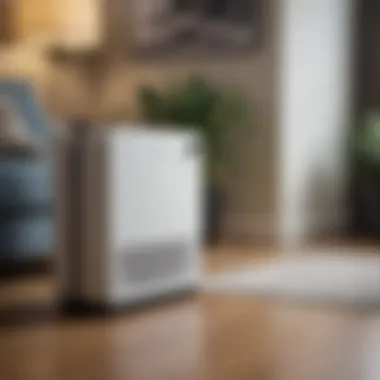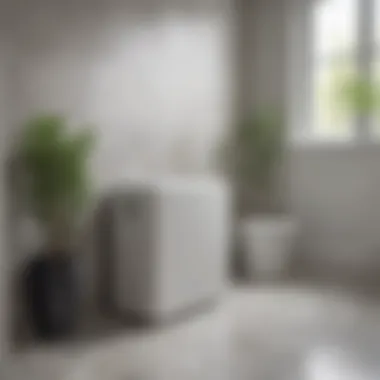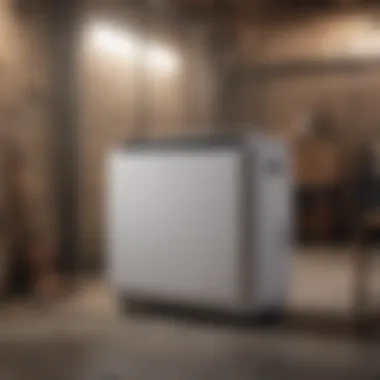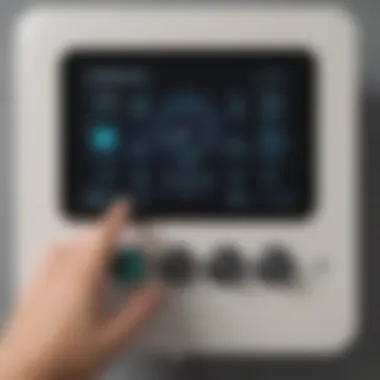Top 5 Dehumidifiers for Optimal Air Quality


Intro
In modern homes, maintaining optimal humidity levels is crucial for comfort and health. Excess humidity can lead to mold growth, musty odors, and discomfort. This article delves into five of the best dehumidifiers currently available, providing a detailed assessment of their features, specifications, and ideal use scenarios. Homeowners and renters who seek better air quality will find this analysis instrumental.
Understanding how dehumidifiers work and what to look for when selecting one can significantly enhance indoor living conditions. In addition to examining specific products, we'll address common myths about dehumidifiers and share maintenance tips, ensuring they remain efficient over time. Whether you're attempting to improve air quality in a damp basement or managing humidity in a small apartment, this guide will offer valuable insights.
Let's proceed to evaluate the best options on the market.
Foreword to Dehumidifiers
The topic of dehumidifiers is crucial for understanding how moisture levels in the home can affect comfort and health. High humidity can lead to mold growth, structural damage, and discomfort. This article aims to unravel the significant role of dehumidifiers in maintaining optimal indoor humidity. Dehumidifiers are not just appliances; they are essential tools for improving air quality and protecting homes.
Understanding Humidity
Humidity refers to the amount of moisture present in the air. High levels of humidity can create a breeding ground for allergens, such as dust mites and mold. It can also cause discomfort by making warm air feel hotter. Conversely, too little humidity can lead to dry skin and respiratory issues. Understanding the balance is key. The ideal indoor humidity level is typically between 30% and 50%. This range supports comfort and inhibits mold growth. Homeowners should monitor humidity levels, especially in areas prone to moisture, such as basements and bathrooms.
The Role of Dehumidifiers
Dehumidifiers serve the essential function of reducing excess moisture in the air. Their role goes beyond just comfort; they are pivotal in maintaining the integrity of the living space. By extracting moisture, dehumidifiers can help prevent mold formation, preserve furnishings, and improve overall air quality. For instance, homes in regions with high humidity may find dehumidifiers to be invaluable during every season.
- Types of Dehumidifiers: There are various types of dehumidifiers, including refrigerant, desiccant, and whole-house models. Each type has its own set of features and benefits that cater to different needs.
- Health Benefits: Using a dehumidifier can alleviate respiratory issues and reduce allergens, making it a beneficial appliance, especially for allergy sufferers.
Studies show that maintaining optimal humidity levels can significantly improve indoor air quality and comfort. Such adjustments lead to better general health for occupants.
In summary, understanding humidity and the role of dehumidifiers provides insight into their necessity. As we explore specific models later in this article, it becomes clear that investing in a reliable dehumidifier can be a prudent decision for homeowners and anyone concerned about air quality.
Criteria for Choosing a Dehumidifier
When selecting a dehumidifier, several factors warrant your attention. Understanding these criteria ensures that you make a choice that aligns with your specific needs and environment. Poor choices can lead to inefficiency and unwanted expenses. Therefore, evaluating the criteria is crucial to find the right dehumidifier.
Capacity and Size
The capacity of a dehumidifier is defined by its ability to remove moisture from the air over time. It is usually measured in pints of water extracted per day. Choosing the right capacity relates directly to the size and humidity levels of the area it will service. Larger rooms with high humidity levels require dehumidifiers with higher capacity.
In residential settings, consider the space where the dehumidifier will be placed. For example, a basement often needs a unit that can remove more moisture compared to a small bathroom. Homeowners should measure the square footage of the space and refer to the manufacturer’s capacity recommendations. This will help avoid underperformance or overheating;
- Low Capacity (30-50 pints): Ideal for spaces up to 1,500 square feet, often used in bathrooms or closets.
- Medium Capacity (50-70 pints): Suitable for medium-sized areas like laundry rooms or basements, up to 2,500 square feet.
- High Capacity (70+ pints): Recommended for large spaces exceeding 2,500 square feet, often required for heavily humid areas.
Energy Efficiency


Energy efficiency is another crucial aspect. A dehumidifier that consumes less energy can significantly reduce your electricity bill. Look for models certified by Energy Star, as these units meet strict energy efficiency guidelines set by the U.S. Environmental Protection Agency. Energy-efficient models often incorporate features like adjustable humidity settings and automatic shut-off, which further enhance their efficiency.
Moreover, consider the unit's energy factor, which indicates how many pints of moisture the unit can remove per kilowatt-hour of electricity consumed. A higher energy factor translates to better efficiency. This consideration is especially relevant for those who intend to run the dehumidifier continuously, as operational costs can accumulate.
Noise Level Considerations
Noise is an often-overlooked factor when purchasing a dehumidifier. While many models operate quietly, others can produce significant sound levels, which may be disturbing in environments such as bedrooms or living areas. Look for dehumidifiers with a decibel rating that suits your preferences.
Generally, a quiet dehumidifier will produce around 40-50 dB, comparable to whispering sounds. If the unit has a continuous drainage option, it can be placed in areas where noise is less of a concern. Reading customer reviews can provide additional insights into the noise levels of specific models.
"Choosing the correct dehumidifier not only optimizes performance but also contributes to better air quality and comfort in your home."
In summary, understanding the criteria involving capacity, energy efficiency, and noise level will make a significant impact on your overall experience with a dehumidifier. Investing time in evaluating these elements can lead to the improvement of your indoor environment.
Overview of the Five Best Dehumidifiers
Choosing a dehumidifier involves understanding the products available. In this section, we will explore five top models, their unique features, and what makes them suitable for various situations. These dehumidifiers not only improve air quality but also prevent issues like mold and mildew, which can result from excess humidity.
Knowing the best options allows readers to make informed decisions. Investing in the right dehumidifier can lead to better indoor air quality, potentially improving health conditions for individuals sensitive to moisture. Each model mentioned here balances performance and features that appeal to specific needs, whether they relate to energy efficiency or noise levels.
Model One - Features and Benefits
Model One, the Frigidaire FFAD7033R1, is notable for its high capacity. It can remove 70 pints of moisture from the air daily, making it ideal for larger spaces. It includes a continuous drainage option, which is useful for extended use without manual intervention. Additionally, its energy star rating demonstrates efficiency, allowing it to operate without significantly increasing energy bills.
Model Two - Features and Benefits
The hOmeLabs 70 Pint Dehumidifier stands out for its user-friendly interface and versatility. It is equipped with a built-in pump that can lift water up to 16.4 feet away. This feature is helpful for basements or areas where a drain is not readily accessible. The digital display is easy to understand, making operation simple.
Model Three - Features and Benefits
For those needing quieter operation, the MIDEA 20 Pint offers a robust solution. With a noise level of only 42 dB, it performs well in bedrooms or study areas. Its compact size is another plus, allowing it to fit into smaller rooms without taking too much space. It has a washable filter that adds to its longevity and ease of maintenance.
Model Four - Features and Benefits
The Vremi 70 Pint Dehumidifier is recognized for its smart features. It comes with multiple modes including a turbo mode for rapid drying in high humidity areas. The sleek design and wheels allow for easy movement throughout a home. Additionally, it’s able to operate at low temperatures, making it a versatile choice for various climates.
Model Five - Features and Benefits
Last, the Toshiba 70 Pint Dehumidifier has advanced features, such as a built-in humidistat and a programmable timer. It offers both continuous drainage options and a bucket for manual collection. This model is particularly noted for its high-efficiency performance and user-friendly settings that accommodate various humidity levels easily.
Key Takeaway: Choosing the right model depends on your specific needs, such as space size, desired features, and noise tolerance.


Overall, understanding the features of these five dehumidifiers will assist readers in picking the ideal one for their unique situations.
Comparing the Best Models
Comparing various dehumidifiers is essential when making an informed choice for your space. Each model offers unique features and capabilities that cater to different needs. It is important to evaluate parameters that directly affect not only the performance but also your overall satisfaction. By understanding the distinctions among models, you can optimize your selection based on factors such as efficiency, functionality, and cost.
This section will delve into two critical aspects: performance metrics and price comparisons. These elements are pivotal for discerning potential buyers looking for the best value. Each dehumidifier may shine in specific scenarios yet may not perform as well in others. Therefore, it is crucial to weigh these aspects thoroughly.
Performance Metrics
When comparing dehumidifiers, evaluating performance metrics is fundamental. Several key factors contribute to how well a model functions. These include:
- Dehumidification Capacity: This denotes how much moisture a unit can extract from the air within a given timeframe, measured in pints per day. A higher capacity indicates a stronger ability to reduce humidity, which is essential in areas with high moisture levels.
- Energy Consumption: Understanding how much electricity a dehumidifier uses is vital for estimating long-term costs. Models with higher energy efficiency ratings can save on electricity bills while maintaining optimal performance.
- Coverage Area: Each dehumidifier is designed to manage different room sizes. Knowing the square footage a unit can effectively service will guide consumers in selecting the right size for their needs. A mismatch can lead to inefficient operation and unsatisfactory results.
- Build Quality and Features: Materials and construction matter. Units with durable designs and features like smart technology for operating remotely often perform better over time. Automatic shut-off functions and built-in humidistats can also enhance usefulness.
"Understanding the performance metrics can significantly influence the quality of your indoor air. It is a key step in making a smart decision."
Price Comparisons
Price is an unavoidable consideration when purchasing a dehumidifier. While it is tempting to opt for the least expensive option, a deeper analysis might yield more value. Factors influencing pricing include:
- Initial Cost: The upfront expenditure on a dehumidifier varies significantly by model and features. High-capacity models with advanced technologies typically command a higher price.
- Operational Costs: Beyond the initial purchase, examining how much a dehumidifier will cost to operate over time is critical. An effective unit may come at a higher price tag, but its energy savings could lead to lower overall costs.
- Warranty and Support: Consider models that offer longer warranties or better customer support services. These can save money on repairs or replacements in the long run.
Common Misconceptions about Dehumidifiers
Dehumidifiers play a significant role in maintaining indoor air quality, yet they are often surrounded by misconceptions. Understanding these misunderstandings can lead to more informed decisions when choosing a dehumidifier. This section highlights common myths and provides clarity on the actual benefits and functions of dehumidifiers.
Dehumidifiers vs. Air Conditioners
A prevalent misconception is that dehumidifiers and air conditioners serve the same purpose. While both units help to control humidity levels, they operate quite differently. An air conditioner primarily cools the air, which indirectly reduces humidity. It does this by circulating air through a cooling system, resulting in condensation that lowers moisture levels.
In contrast, a dehumidifier specifically targets humidity without significant temperature changes. This can be particularly useful in spaces where cooling is not required. Homeowners might mistakenly believe that they only need an air conditioner for humidity control, but this is not necessarily the case. In humid climates or in areas like basements, a dehumidifier can be more effective and efficient in managing moisture levels.
Furthermore, dehumidifiers tend to consume less energy than air conditioners while maintaining comfort. Those seeking to improve air quality in homes with high humidity should consider the distinct roles of each device.
Do Dehumidifiers Consume Excessive Energy?
Another common misconception is that dehumidifiers waste energy and drive up utility bills. In fact, modern dehumidifiers are designed for energy efficiency. Many models come with Energy Star certification, meaning they use significantly less energy than standard models.
Factors that contribute to energy consumption include:


- Capacity: Larger units may use more energy but are suitable for bigger spaces.
- Continuous Operation: Running the unit continuously without intervals can increase energy costs.
- Moisture Levels: Higher humidity levels require more energy to bring moisture down to a comfortable level.
While using a dehumidifier will add to electricity costs, the increase is often minor compared to the benefits of improved air quality. Homeowners should focus on maximizing efficiency by choosing the right size unit and setting it properly to avoid unnecessary energy use. It is wise to consult user reviews and energy guidelines to select a model that balances performance with energy consumption.
"Understanding the operational differences and efficiency of dehumidifiers can drastically improve your home environment without excessive energy costs."
Ultimately, replacing misconceptions with factual knowledge empowers homeowners to utilize dehumidifiers effectively and to appreciate their benefits for maintaining optimal indoor air quality.
Maintenance Tips for Longevity
Maintaining a dehumidifier is crucial for ensuring its efficiency and lifespan. Many users overlook the upkeep, which can lead to reduced performance, increased energy consumption, and even damage. By following some simple maintenance tips, one can enhance the performance of their dehumidifier. It will not only save on energy bills but also ensure that the unit operates optimally. This section will delve into the essential cleaning guidelines and proper storage practices necessary for longevity.
Regular Cleaning Guidelines
Regular cleaning of a dehumidifier is vital. Dust, mold, and other contaminants can accumulate in and around the unit, affecting air quality and functionality. Here are several important steps to consider:
- Filter Cleaning: The air filter should be checked frequently, ideally every two weeks. A dirty filter hinders airflow and reduces efficiency. Clean it with warm, soapy water, ensuring it is completely dry before reinstalling.
- Water Tank Care: Empty the water tank regularly. Standing water can become a breeding ground for mold and bacteria. Clean the tank with vinegar or a mild detergent to remove any residue.
- Coil Maintenance: The coils should be checked periodically for dust buildup. A soft brush or vacuum can be used to gently clean them without causing damage.
- Exterior Wipe Down: Wipe the exterior of the unit with a damp cloth to keep it clean. Accumulated dust can obstruct ventilation.
By adhering to these cleaning guidelines, you can significantly improve the operational lifespan of your dehumidifier while maintaining a healthy home environment.
Proper Storage Practices
When not in use, proper storage of a dehumidifier is essential to prevent deterioration. Here are key considerations:
- Unplugging the Unit: Always unplug the dehumidifier when it is not in operation. This prevents any electrical issues and conserves energy.
- Draining Water Tank Completely: Make sure to drain any residual water from the tank. Leaving water inside can lead to mold growth, which will be problematic when the unit is used again.
- Storing in a Dry Place: Find a dry, cool place for storage. Extreme humidity can negatively impact the internal components.
- Covering the Unit: If possible, cover the dehumidifier with a cloth or plastic cover to protect it from dust and debris during storage.
By implementing these proper storage practices, one can protect the dehumidifier from wear and tear, ensuring it remains in good working condition for future use.
Following these guidelines will help maintain not just the dehumidifier but also the quality of the air in your living space.
Closure and Recommendations
Selecting a dehumidifier may seem straightforward, but it involves careful consideration to meet specific needs. The significance of this section lies in its ability to distill all the relevant information presented in previous sections, enabling readers to make informed choices. A well-chosen dehumidifier can not only enhance comfort levels within a living space but can also protect property from the damaging effects of excessive moisture.
Summary of Key Points
Throughout this article, various key points emerge:
- Understanding Humidity: Recognizing how humidity affects indoor air quality and comfort is crucial.
- Dehumidifier Functions: The primary role of dehumidifiers is to reduce moisture levels, improving air quality and preventing mold growth.
- Choosing Criteria: Factors such as capacity, energy efficiency, and noise levels significantly impact selection.
- Comparative Analysis: Evaluating performance metrics and prices of top-rated models can aid in making an educated decision.
- Misconceptions Addressed: Clarifying the differences between dehumidifiers and air conditioners, and dispelling myths about their energy consumption can alleviate concerns about their use in households.
By synthesizing these points, readers can better grasp the broader implications of their choices when it comes to dehumidifiers.
Final Thoughts on Selection
When it comes to selecting a dehumidifier, the process should align with individual requirements and environmental factors. Here are a few critical considerations:
- Space and Capacity: Assess the size of the area where the dehumidifier will be used. Larger spaces require units with higher capacity.
- Budget Constraints: Determine the budget for purchase while considering the long-term operational costs, as energy-efficient models, while possibly more expensive upfront, provide savings over time.
- Noise Levels: Opt for models that operate quietly if the dehumidifier will be used in bedrooms or offices.
- Maintenance: Be mindful of maintenance needs, such as filter changes and water tank emptying. Some models have continuous drainage features which can simplify this task.















